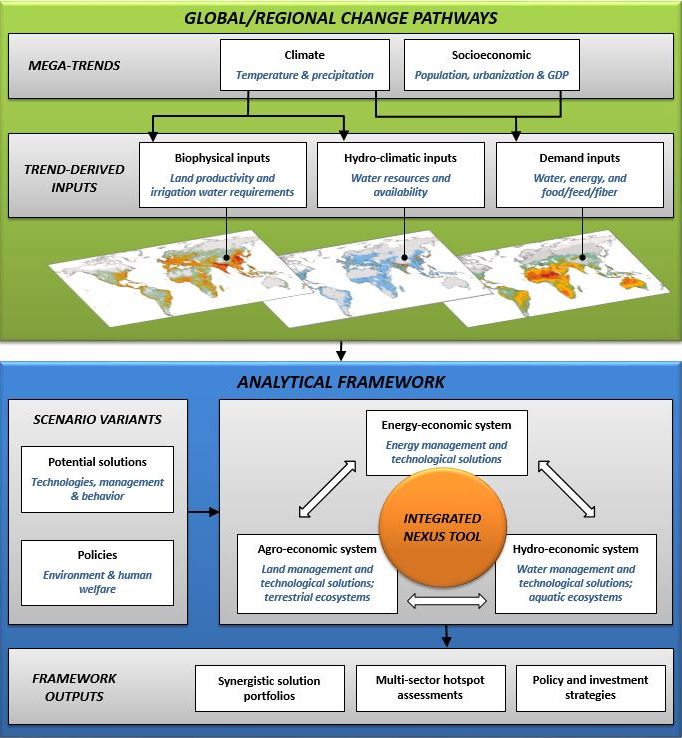Sustainable use of water, energy, and land
The Integrated Solutions for Water, Energy, and Land (IS-WEL) project is developing a tool to assess these three resources, and demand for them, around the world. By incorporating the interlinkages among the resources, the project will support decision makers in developing robust, sustainable policies. The Indus and Zambezi river basins will form the first two case studies for the tool.
Demand for water, energy, and food—the mainstays of life—is rapidly rising around the world. This is particularly true in the Global South, which also includes the regions that are most vulnerable to climate change. Considering the interlinkages among the three resources is vital, because policies designed without such knowledge can cause food crises and environmental degradation.
The IS-WEL project aims develop an integrated assessment framework that can support long-term and sustainable planning for water, energy, and food resources at global to regional scales. It will also identify hotspots of demand and provide cost-effective interventions. Importantly, the project will work in an inclusive way, engaging relevant stakeholders, decision makers, and investors to co-develop solutions for meeting sustainable development goals.
Although there has been some success in linking models of different sectors, a new review by IS-WEL researchers shows that the development of frameworks capable of assessing the intersection of all three resources has been limited, and there is substantial scope for improvement [1]. The study also highlights existing knowledge gaps and opportunities for future research, including:
- the need to develop assessment frameworks based on consistent and regionally-transferable platforms that can be used at different spatial scales;
- the lack of spatially-explicit techno-economic models, particularly for the energy and water sectors;
- the need to have an improved representation of nexus impacts on environmental quality and of implementation challenges related to limited financial and institutional capacity;
- an improved tracking of energy and land requirements across sectors;
- improved representation of the role of distribution infrastructure in alleviating resource challenges; and
- a dynamic multi-sectoral hotspot assessment.
In 2016 the first scientific papers from the project, analyzing a variety of resource interactions, constraints, and potential synergies, were published [2][3][4][5][6][7][8]. The IIASA Transitions to New Technologies Program also recruited a new research scholar who will contribute to IS-WEL research through a multi-dimensional technology assessment of nexus technologies.
To accomplish IS-WEL’s ambitious goals, a major alliance has been built across the Energy, Transitions to New Technologies, Water, and Ecosystems Services and Management programs at IIASA. This cooperation will link traditionally separate resource management models of water, energy, and land use into a next-generation integrated systems analysis framework.
References
[1] Johnson N, Burek P, Parkinson S, Byers E, Flörke M, Havlik P, Hejazi M, Krey V, et al. Integrated Assessment of the Land-Energy-Water Nexus: Status, Challenges and Research Opportunities, Environmental Research Letters (submitted).
[2] Byers E, Hall JW, Amezaga JM, O’Donnell GM, & Leathard A (2016). Water and climate risks to power generation with carbon capture and storage. Environmental Research Letters 11 (2): 024011.
[3] Fricko O, Parkinson S, Johnson N, Strubegger M, van Vliet MTH, & Riahi K (2016). Energy sector water use implications of a 2°C climate policy. Environmental Research Letters 11 (3): e034011.
[4] Mentis D, Andersson M, Howells M, Rogner H, Siyal S, Broad O, Korkovelos A, & Bazilian M (2016). The benefits of geospatial planning in energy access – A case study on Ethiopia. Applied Geography 72: 1-13.
[5] Obersteiner M, Walsh B, Frank S, Havlik P, Cantele M, Liu J, Palazzo A, Herrero M, et al. (2016). Assessing the land resource-food price nexus of the Sustainable Development Goals. Science Advances 2 (9): e1501499.
[6] Parkinson S, Johnson N, Rao N, Jones B, van Vliet M, Fricko O, Djilali N, Riahi K, et al. (2016). Climate and human development impacts on municipal water demand: A spatially-explicit global modeling framework. Environmental Modelling & Software 85: 266-278.
[7] van Vliet MTH, Wiberg D, Leduc S, & Riahi K (2016). Power-generation system vulnerability and adaptation to changes in climate and water resources. Nature Climate Change 6 (1): 375-381.
[8] Byers E, Qadrdan L, Hall J, Amezaga J, Chaudry M, Kilsby C, Martino T, & Alderson D (2016). Water use and water availability constraints to decarbonised electricity systems. In: European Geosciences Union (EGU) General Assembly 2016, 17–22 April 2016, Vienna, Austria.

